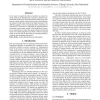Free Online Productivity Tools
i2Speak
i2Symbol
i2OCR
iTex2Img
iWeb2Print
iWeb2Shot
i2Type
iPdf2Split
iPdf2Merge
i2Bopomofo
i2Arabic
i2Style
i2Image
i2PDF
iLatex2Rtf
Sci2ools
INTERSPEECH
2010
2010
The relation between pitch perception preference and emotion identification
In our study, we explore the effect of synthetic vs analytic listening mode on the identification of emotions. Numerous psychoacoustic studies have shown that listeners differ in how they process complex sounds; some listeners focus on the fundamental frequency while others attend to the higher harmonics. The difference appears to have a neurological basis, expressed in a leftward (for F0 listeners) or rightward (for spectral listeners) asymmetry of gray matter volume in the lateral Heschl's gyrus. In our experiment we found that spectral listeners performed better in an emotion judgment task, which is what we expected based on the fact that the processing of emotional prosody is relatively right-hemisphere lateralized.
INTERSPEECH 2010 | Numerous Psychoacoustic Studies | Signal Processing | Spectral Listeners | Vs Analytic Listening |
| Added | 18 May 2011 |
| Updated | 18 May 2011 |
| Type | Journal |
| Year | 2010 |
| Where | INTERSPEECH |
| Authors | Marie Nilsenová, Martijn Goudbeek, Luuk Kempen |
Comments (0)

